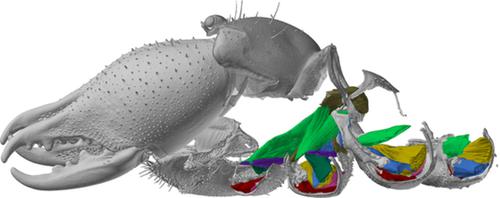当前位置:
X-MOL 学术
›
J. Morphol.
›
论文详情
Our official English website, www.x-mol.net, welcomes your feedback! (Note: you will need to create a separate account there.)
Evolutionary and functional substitution of extrinsic musculature in Solifugae (Arachnida)
Journal of Morphology ( IF 1.5 ) Pub Date : 2020-10-26 , DOI: 10.1002/jmor.21260 Jens Runge 1 , Christian S. Wirkner 1
Journal of Morphology ( IF 1.5 ) Pub Date : 2020-10-26 , DOI: 10.1002/jmor.21260 Jens Runge 1 , Christian S. Wirkner 1
Affiliation

|
The locomotory system of Solifugae is distinct from that of other Arachnida in several ways. Only three pairs of legs are involved in locomotion, while the first pair function as sensory appendages. Morphologically, the proximal region of the locomotory system in Solifugae is characterized by fused coxae. Within the prosoma of Solifugae, an endosternite is missing: in other Arachnida, this endosternite serves as the proximal attachment site for a portion of the extrinsic musculature. How then do these skeletal modifications influence the muscular anatomy in the proximal region of the locomotory system? To answer this question, we studied the skeletomuscular anatomy of Galeodes granti at the interface between the prosoma and legs, reinvestigating the complex muscular anatomy of this body region for the first time in over 80 years and—for the first time—using detailed micro‐computed tomography scans to analyze the skeletomuscular morphology. Specimens of three further species were checked for comparison. The analysis revealed differences in the number and composition of coxa‐trochanter muscles in each of the four pairs of legs. These are compared in the light of serial homology. The comparison between the proximal locomotory system of Solifugae and that of other Arachnida unveils a series of analogies. Primarily, the coxa‐trochanter joint is the most proximal joint to move the leg relative to the prosoma. Therefore, we argue that from a morpho‐functional point of view, the coxa‐trochanter muscles in Solifugae should be considered secondary extrinsic musculature. Thus, the legs gain a stable, articulated joint in the most proximal region of the leg to the prosoma, which might be advantageous for agile locomotion.
中文翻译:

Solifugae(蛛形纲)中外在肌肉组织的进化和功能替代
Solifugae 的运动系统在几个方面与其他蛛形纲的运动系统不同。只有三对腿参与运动,而第一对腿起感觉附属物的作用。在形态学上, Solifugae 运动系统的近端区域以融合的 coxae 为特征。在 Solifugae 的前体中,缺少一个内骨:在其他蛛形纲动物中,这个内骨作为一部分外在肌肉组织的近端附着点。那么,这些骨骼改变如何影响运动系统近端区域的肌肉解剖结构?为了回答这个问题,我们研究了前体和腿之间界面处的 Galeodes granti 的骨骼肌肉解剖结构,80 多年来首次重新研究该身体区域的复杂肌肉解剖结构,并首次使用详细的微型计算机断层扫描来分析骨骼肌肉形态。检查了另外三个物种的标本以进行比较。分析揭示了四对腿中每一对的髋转子肌肉的数量和组成存在差异。这些根据序列同源性进行比较。Solifugae 的近端运动系统与其他蛛形纲动物的近端运动系统之间的比较揭示了一系列类比。首先,髋转子关节是使腿相对于前体移动的最近端关节。因此,我们认为,从形态功能的角度来看,Solifugae 的髋转子肌肉应被视为次要的外在肌肉组织。因此,
更新日期:2020-10-26
中文翻译:

Solifugae(蛛形纲)中外在肌肉组织的进化和功能替代
Solifugae 的运动系统在几个方面与其他蛛形纲的运动系统不同。只有三对腿参与运动,而第一对腿起感觉附属物的作用。在形态学上, Solifugae 运动系统的近端区域以融合的 coxae 为特征。在 Solifugae 的前体中,缺少一个内骨:在其他蛛形纲动物中,这个内骨作为一部分外在肌肉组织的近端附着点。那么,这些骨骼改变如何影响运动系统近端区域的肌肉解剖结构?为了回答这个问题,我们研究了前体和腿之间界面处的 Galeodes granti 的骨骼肌肉解剖结构,80 多年来首次重新研究该身体区域的复杂肌肉解剖结构,并首次使用详细的微型计算机断层扫描来分析骨骼肌肉形态。检查了另外三个物种的标本以进行比较。分析揭示了四对腿中每一对的髋转子肌肉的数量和组成存在差异。这些根据序列同源性进行比较。Solifugae 的近端运动系统与其他蛛形纲动物的近端运动系统之间的比较揭示了一系列类比。首先,髋转子关节是使腿相对于前体移动的最近端关节。因此,我们认为,从形态功能的角度来看,Solifugae 的髋转子肌肉应被视为次要的外在肌肉组织。因此,



























 京公网安备 11010802027423号
京公网安备 11010802027423号